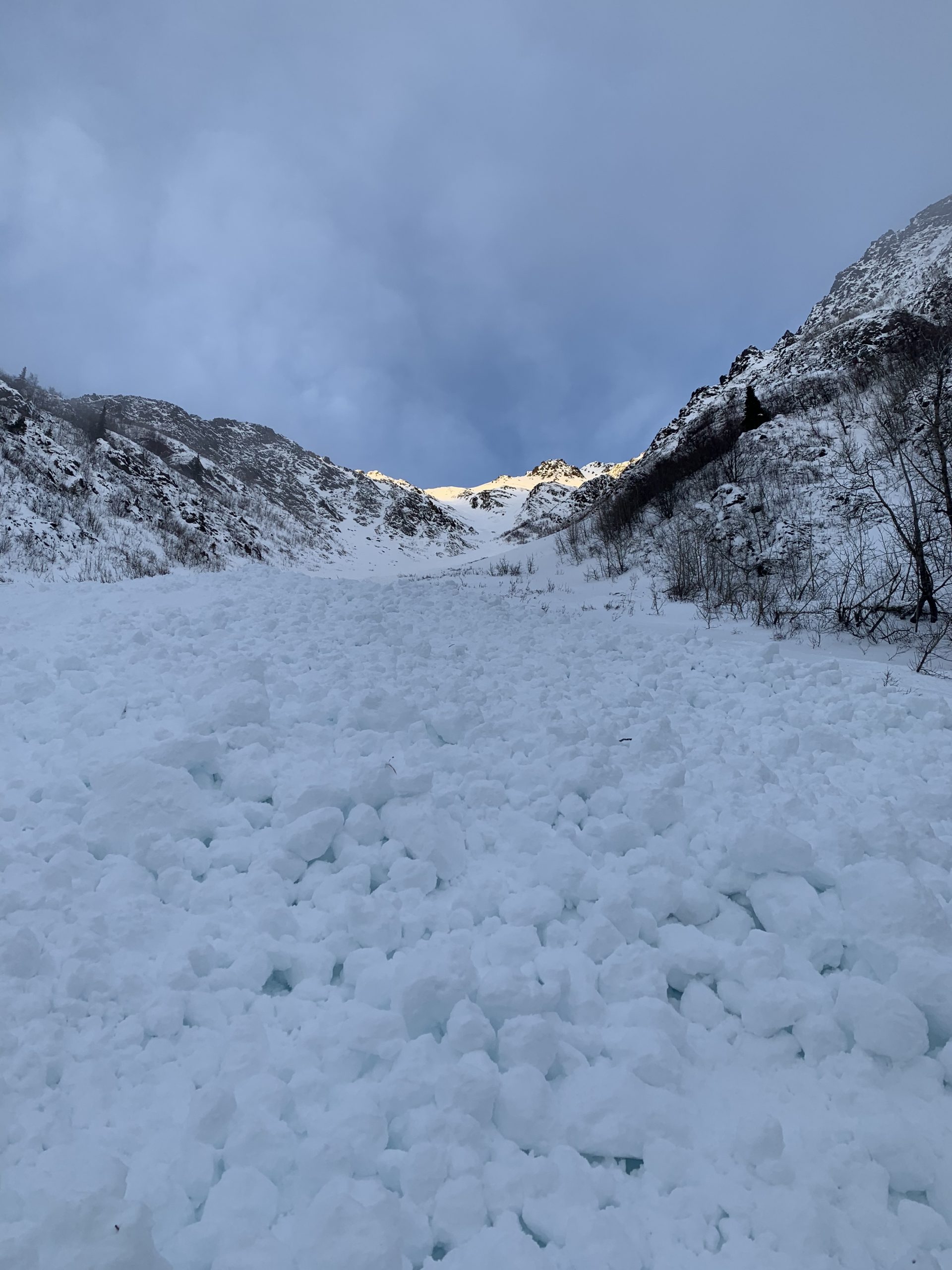Well… it looks like one more day of this wild warm weather before things start to cool off tomorrow. The warmest temperatures have been at the upper elevations (30-40F) for two days now. This has melted the surface and formed a thin wet (or crusty) layer capping the snowpack from valley bottoms to ridgetops. Temperatures have cooled overnight under clear(ish) skies, but with continued warm ambient air along with clouds forecast this afternoon with some light rain, the surface crusts should soften through the day.
This dramatic warm up has not produced any avalanche activity that we know of in Turnagain Pass or areas that have a thick snowpack (around 6′ or more). But… it has been able to affect the shallow snowpack areas, which mostly lie just outside the forecast zone (i.e. Summit Lake). These are the areas to be most suspect of until the pack freezes up. As we can see in Andrew’s report from Fresno, the first day of the warm up (Sunday), which coincided with strong westerly winds, produced some significant avalanche activity that broke in weak layers only buried around 2′ deep.
Things to think about for today are:
- Are you in an area that has a thick snowpack or a thin snowpack?
- If you are in a thin snowpack, it’s best to steer clear of steep slopes and not mess with avalanche terrain.
- What are the snow surface conditions? Crusty or wet?
- If the surface is wet, how wet? Potentially wet enough to trigger a wet loose avalanche on a steep slope? Maybe late today if a little rain does fall.
- Look for any signs of instability or avalanches that have occurred in the past two days. Avoid similar slopes if you see any signs of recent avalanches.
The faceted layers that sit above the Halloween crust are still there of course, as shown in the pit from Seattle Ridge below. They continue to show signs of being squished and strengthening in those thicker snowpack areas, but we are still looking out for any signs showing otherwise. Right now, all signs point to where those facets are weaker and closer to the surface, hence the shallow zones.
 Snowpack structure at 2,800′ above Main Bowl on a NE facing slope. Total snow depth was 7 feet. We could not get the weak layer to fail in this location. 12.27.21.
Snowpack structure at 2,800′ above Main Bowl on a NE facing slope. Total snow depth was 7 feet. We could not get the weak layer to fail in this location. 12.27.21.
Glide Avalanches: Some glide cracks are re-opening around the region. Keep your eye out for them. This one below is from Seattle Ridge in Warmup Bowl.
 Glide crack on Seattle Ridge’s Warmup Bowl that is opening back up. 12.27.21.
Glide crack on Seattle Ridge’s Warmup Bowl that is opening back up. 12.27.21.


 Large natural avalanche on Fresno, likely occurred during Sunday’s (12.26.21) strong westerly winds. Avalanche up to 2,800′ wide and suspected to break in advanced facets buried around 2′ deep. Photo taken 12.27.2021.
Large natural avalanche on Fresno, likely occurred during Sunday’s (12.26.21) strong westerly winds. Avalanche up to 2,800′ wide and suspected to break in advanced facets buried around 2′ deep. Photo taken 12.27.2021. Natural wet avalanche that released on Sunday when a skier was lower on the snow. Skier was able to get out of the way after being washed over by a first wave of snow. Photo by skier, 12.26.21.
Natural wet avalanche that released on Sunday when a skier was lower on the snow. Skier was able to get out of the way after being washed over by a first wave of snow. Photo by skier, 12.26.21. Snowpack structure at 2,800′ above Main Bowl on a NE facing slope. Total snow depth was 7 feet. We could not get the weak layer to fail in this location. 12.27.21.
Snowpack structure at 2,800′ above Main Bowl on a NE facing slope. Total snow depth was 7 feet. We could not get the weak layer to fail in this location. 12.27.21. Glide crack on Seattle Ridge’s Warmup Bowl that is opening back up. 12.27.21.
Glide crack on Seattle Ridge’s Warmup Bowl that is opening back up. 12.27.21.